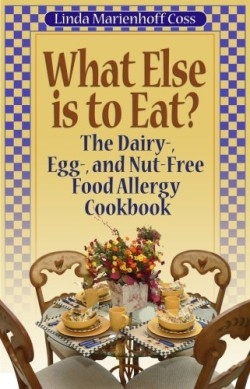What Else is to Eat?
The Dairy-, Egg-, and Nut-Free Food Allergy Cookbook
Living with food allergies not only limits your eating choices, it can also threaten your life. According to the Food Allergy and Anaphylaxis Network, food allergy is believed to be the leading cause of anaphylaxis outside hospitals, causing an estimated 30,000 trips to emergency rooms every year. But even food allergy sufferers who don’t experience such extreme reactions deal with unpleasant symptoms such as nausea, diarrhea, hives, and asthma. What Else Is To Eat? aims to help families avoid the dreaded effects of eating forbidden foods by offering a variety of tempting kid- and adult-friendly recipes.
This book addresses cooking for those who are allergic to dairy, eggs, peanuts, and tree nuts only. (The author does not cover wheat, soy, or shellfish, other common food allergies.) Marienhoff Coss emphasizes simplicity and short preparation times in her recipes which span a wide range of culinary offerings including meats, soups, salads, fish, rice, vegetables, desserts, and breakfast foods. Rounding out the book are menu ideas and a glossary of cooking terms for novice home chefs. A “Resources” page directs readers to the author’s Web site.
The recipes are quick and easy to prepare—a deal for time-starved parents. Many of them consist of only five or six ingredients, like the delicious Dill Pan Roasted Carrots and Mom’s Meat Loaf. Also included are handy and practical slow-cooker recipes, a boon after a long workday. The recipes will appeal to all family members, and even picky eaters should appreciate Steak on a Stick and Double Chocolate Decadence Cake. Baking without the use of eggs as a binding agent can be a tricky affair but the author’s cookie chapter, which includes classic favorites like Chocolate Chocolate Chip and Molasses Chewies, will ensure that no one has to feel deprived.
Marienhoff Coss wrote her first cookbook, What’s To Eat? more than fifteen years ago when her children were small and food allergy awareness was limited. She follows it up with this expanded edition. She has also written How to Manage Your Child’s Life-Threatening Food Allergies.
The author uses a few interesting ingredients like hoisin sauce and apricot jam, but she relies too heavily on orange as a flavoring agent. She also could have explored other grains besides rice such as millet, quinoa, and spelt, to name a few. But her recipes are appetizing, easy to follow, and unlikely to elicit quizzical looks across the dinner table. Allergy cooking can be a challenge even for experienced cooks, but this book offers kitchen-tested dishes that are both palate-pleasing and safe.
Reviewed by
Luise Bolleber
Disclosure: This article is not an endorsement, but a review. The publisher of this book provided free copies of the book to have their book reviewed by a professional reviewer. No fee was paid by the publisher for this review. Foreword Reviews only recommends books that we love. Foreword Magazine, Inc. is disclosing this in accordance with the Federal Trade Commission’s 16 CFR, Part 255.

